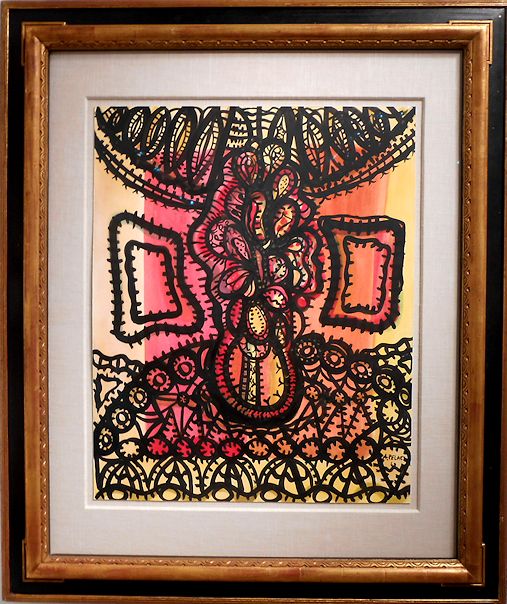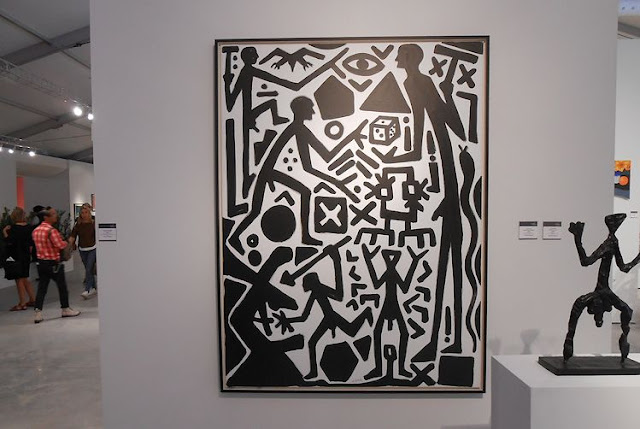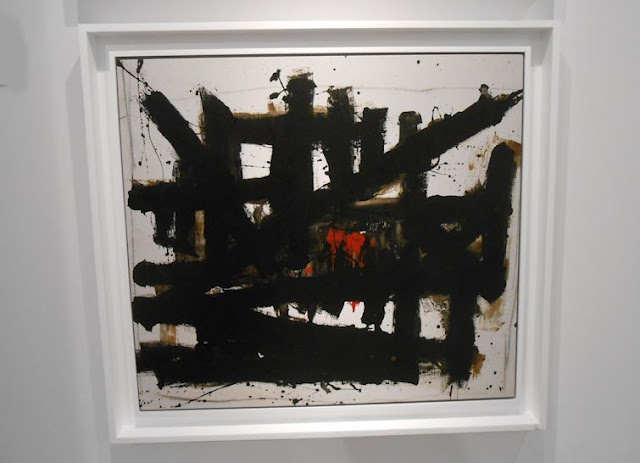On Monday I drove to Miami and spent the day in the Wynwood District, just north of
downtown, enjoying this year's Wynwood Murals. Beginning in 2009, Tony Goldman, who
had bought much of the run-down former clothing district, decided to invite the best
graffiti artists in the world to come and decorate the walls of small factories and warehouses.
Artists arrive in early November so that they will have the murals completed in time
for Art Miami and Art Basel the first week of December.
graffiti artists in the world to come and decorate the walls of small factories and warehouses.
Artists arrive in early November so that they will have the murals completed in time
for Art Miami and Art Basel the first week of December.
To your right as you enter is the great Kenny Scharf mural of graffiti figures.
Kenny Scharf is a famous New York street artist who has repainted this mural several
times because it is so well-loved by visitors. More than a million people now come
each year to enjoy the murals.
FUTURA. "Modern Painting Wall." This is across from Kenny Scharf's wall.
Futura is the pseudonym of Lenny McGurr born in 1955 in New York. Growing up on
103rd Street in Brooklyn during the boom years of train bombing, McGurr was introduced
to graffiti in the late ‘60s and early ‘70s while he was traveling to school.
He introduced abstraction into a previously letter-based art form by covering whole cars
of the city’s subway trains with his expressive paintings. Futura helped define the
graffiti movement of the early 1970s by moving it away from lettering and towards the
more painterly, abstract style.
There are five courtyards in "Wynwood Walls." The third wall in the first court is
Shepard Fairey's "Tribute to Tony." Shepard is perhaps the most famous graffiti artist in
America. On the left is Burmese opposition leader Aung San; on the right is Martin Luther
King Jr. In the center is Tony Goldman, developer and founder of Wynwood Walls with
arms open to welcome all the guest; he died in 2012. It is about peaceful resistance,
climate change, and war and peace.
Shepard Fairey. "Tribute to Tony." There are a number of portraits, symbols, and different
languages in the mural. There are references to climate change and war.
A lotus is a symbol of purity and perfection for many. "OBEY" is a theme which
Shepard often uses.
Shepard often uses.
As you move on to the second court, "The Bedouin" by Okuda from Spain greets you.
Almost all of the murals are made with spray paint cans, the preferred medium of
graffiti artists, because they have to work fast and move on before the police arrive.
Almost all of the murals are made with spray paint cans, the preferred medium of
graffiti artists, because they have to work fast and move on before the police arrive.
On another wall of this court is the gigantic "Blue Face" by David Choe, a Korean-American
artist. Visitors like to pose in front of the murals.
Usually, graffiti artists sign their names at the bottom right of their murals.
A third wall of the court is "Pow! Wow!" by Pro 176, a French street artist.
Most graffiti artists choose a nickname for themselves.
Most graffiti artists choose a nickname for themselves.
The fourth side of the square is the "Birdcage" by Pixel Pancho.
The third court has this brand new mural by Tristan Eaton of Los Angeles.
"The Couple" by INTI, a Chilean artist, has been here several years.
CRASH! "Comic Characters." Another side of the court.
Opposite the "Comics" is "The Hunt" by South African artist, Faith XLVII.
A pride of lions attack a reindeer.
A pride of lions attack a reindeer.
At one corner of the court is a gate leading out. This is a new mural by
Joe Lurat entitled "Wynwood Walls - The Boys."
If you walk through the doors, this is the opposite side.
And in this small outside court is an anamorphic image by Leon Keer, "The Polaroid
and Barbie." The lower part of the polaroid is painted flat on the sidewalk, but gives the
illusion it is raised a foot and the paper bends.
The fourth court is very large and has many murals. Ron English's "The Stag and Hulk Boy"
is several years old but very popular and serves as background for millions of photos
of visitors.
All along the street side is a long mural by the "London Police," actually two men
from Holland.
More of the fence mural by the "London Police."
The opposite side has a number of separate murals / paintings.
Alexis Diaz. "The Mastodon" is an old favorite. Puerto Rico.
"The Ship with Neptune's Portrait Below."
Zawacki. "Up Arrows." This is a new mural.
Audrey Kawasaki. "The Tibetan Princess." The Ram / Aries is the sign of the
zodiac for strength and power, and it is the sign of the artist and the way
she imagines a Tibetan princess.
Dasic Fernandez. "Hummingbird and Inverse Paint Drops." Chile / Brooklyn.
Tatiana Suarez. "Eve and the Lizard." Miami Street Artist.
"Boys Building an Elephant" by a Lithuanian street artist.
But one of the most important murals of this court is the very large and complex "RESIST"
by Lady Pink. It is composed of the six letters of the word, painted in graffiti style, with
many images in each letter. They are so interesting, I want to show several.
Lady Pink was born in Ecuador, but raised in NYC. In 1979 she started writing graffiti
and soon was well known as the only female capable of competing with the boys in the
graffiti subculture. Pink painted subway trains from the years 1979-1985.
Lady Pink was born in Ecuador, but raised in NYC. In 1979 she started writing graffiti
and soon was well known as the only female capable of competing with the boys in the
graffiti subculture. Pink painted subway trains from the years 1979-1985.
The letter "R" has the word, a woman's face, an artist painting, a welcome sign,
a Confederate flag, barbed wire, and more.
The letter "E" has a message of peace and hope and brotherhood, but also the
White House going up in flames and the Statue of Liberty sinking into the
hot lava of hell.
The "I" or perhaps "Ego" refers to a political figure standing amidst skulls and
the fires of hell.
The second "S" is a fantasy of Florida, disappearing polar bears, and air pollution.
The fifth court has one of the most popular murals, "The Fingers" by Cave, a German
street artist. By overlapping hands, he communicates a strong message of unity and power
– leaving the viewer to visualize their own story. Having worked in over 20 countries,
he has literally left his fingerprints in each, continuously leaving bits and pieces
of a language understood by all.
– leaving the viewer to visualize their own story. Having worked in over 20 countries,
he has literally left his fingerprints in each, continuously leaving bits and pieces
of a language understood by all.
Case Maclaim – real name Andreas von Chrzanowski, born 1979 – started developing
his technique in 1995 when he began using spray cans. The German born and raised artist
is a founding member of the graffiti crew Ma’claim, which he founded along with
fellow artists Akut and Rusk in 1999. The international group is considered pioneers of
photo-realistic art in the graffiti scene.
his technique in 1995 when he began using spray cans. The German born and raised artist
is a founding member of the graffiti crew Ma’claim, which he founded along with
fellow artists Akut and Rusk in 1999. The international group is considered pioneers of
photo-realistic art in the graffiti scene.
Hands can express power, vulnerability, anger, peace signs, movement or several emotions
at once. A hand held up with the palm facing you can mean stop. Turn it around and
it beckons the viewer on.
Cave. "Fingers." German. Close-up.
eL Seed "Calligraphy Wall." French Tunisian.
eL Seed had a mural here the past two years, but this one is completely new, and the
colors are very different from last year. Arab calligraphy lends itself to
infinite variations and styles.
eL Seed. "The Calligraphy Wall." French Tunisian.
__
















































































